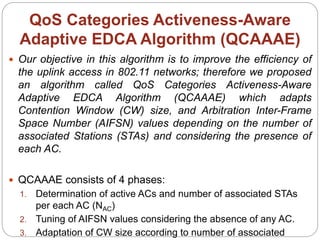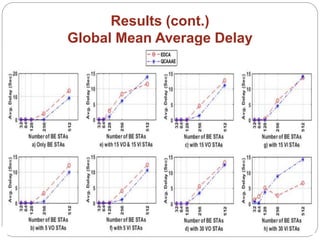QoS Categories Activeness-Aware Adaptive EDCA Algorithm for Dense IoT Networks
- 1. Reference: Mohammed A. Salem, Ibrahim F. Tarrad, Mohamed I. Youssef, and Sherine M. Abd El-Kader, QoS Categories Activeness-Aware Adaptive EDCA Algorithm for Dense IoT Networks, International Journal of Computer Networks & Communications (IJCNC), vol. 11, No. 3, May 2019, pp. 67-83. QoS Categories Activeness-Aware Adaptive EDCA Algorithm for Denese IoT Networks International Journal of Computer Networks & Communications (IJCNC) (Scopus, ERA Listed) ISSN 0974 - 9322 (Online); 0975 - 2293 (Print) http://airccse.org/journal/ijcnc.html
- 2. Outline Traditional IEEE 802.11 EDCA Channel Access QoS Categories Activeness-Aware Adaptive EDCA Algorithm (QCAAAE) Determination of active ACs and number of associated STAs per each AC Tuning of AIFSN values considering the absence of any AC Adaptation of CW size according to number of associated STAS per each AC Advertising the new values of AIFSN and CW Results Conclusions
- 3. Traditional IEEE 802.11 EDCA Channel Access This mechanism provides four Access Categories (ACs): Voice (VO), Video (VI), Best Effort (BE), and Background (BK). The differentiation between ACs is provided by configuring different EDCA parameters (AIFSN, CW) values for each AC; lower AIFSN and CW assigned for higher priority AC.
- 4. Traditional IEEE 802.11 EDCA Channel Access (Cont.) Once STA sensed the channel idle for AIFSN slots, it generates a random back-off time within range from zero to CWmin). STA starts to decrement the back-off time until it reaches to zero, at that time the STA starts to send its frame. In case of the channel becomes busy during the decrement, the back-off time stops and wait till the channel becomes idle to continue the decrement process. In case of unsuccessful transmission, the STA multiply the CW size by 2. AC AIFSN CWmin CWmax VO 2 3 7 VI 2 7 15 BE 3 15 1023 BK 7 15 1023
- 5. QoS Categories Activeness-Aware Adaptive EDCA Algorithm (QCAAAE) Our objective in this algorithm is to improve the efficiency of the uplink access in 802.11 networks; therefore we proposed an algorithm called QoS Categories Activeness-Aware Adaptive EDCA Algorithm (QCAAAE) which adapts Contention Window (CW) size, and Arbitration Inter-Frame Space Number (AIFSN) values depending on the number of associated Stations (STAs) and considering the presence of each AC. QCAAAE consists of 4 phases: 1. Determination of active ACs and number of associated STAs per each AC (NAC) 2. Tuning of AIFSN values considering the absence of any AC. 3. Adaptation of CW size according to number of associated
- 6. Determination of active ACs and number of associated STAs per each AC During association process, every STA send an association request frame which contains QoS capability information. Each STA sets AC flags (B0, B1, B2, and B3) to 1 to inform the AP of the required type(s) of QoS AC for sending and receiving data. We calculated NAC for each category as follows: For every received association request frame, AP checks the flags of each required AC. In case of any AC flag found 1, the corresponding NAC increments. In contrast, for every disassociation request, the corresponding NAC decrements.
- 7. Tuning of AIFSN values considering the absence of any AC Lower priority ACs can improve its performance in terms of throughput, and delay by seizing opportunistically the resources of absent higher priority ACs. For example, if voice and video ACs are inactive, then best effort AC will seize the minimum value of AIFSN which equal 2 to decrease its media access delay. AC Activity Status AIFSN Values VO VI BE VO VI BE Inactive Inactive Active - - 2 Inactive Active Inactive - 2 - Inactive Active Active - 2 3 Active Inactive Inactive 2 - - Active Inactive Active 2 - 3 Active Active Inactive 2 3 - Active Active Active 2 3 4
- 8. Adaptation of CW size according to number of associated STAS per each AC The new CWmin and CWmax values are given by:
- 9. Advertising the new values of AIFSN and CW The AP broadcasts out periodically a beacon frame in the network, which contains all information about the networkand a field for EDCA parameters setting. In QCAAAE; after tuning of AIFSN value and calculation of CW size for each AC, the AP updates the EDCA parameters setting field and advertise all associated and connected STAs through the next scheduled beacon frame.
- 11. Results (cont.) Global Mean Average Delay
- 12. Results (cont.) Global Retransmission Attempts
- 13. Results (cont.) Best Effort AC Normalized Throughput
- 14. Results (cont.) Voice AC Normalized Throughput
- 15. Results (cont.) Voice AC Mean Average Delay
- 16. Results (cont.) Video AC Normalized Throughput
- 17. Results (cont.) Video AC Mean Average Delay
- 18. Conclusions The QCAAAE algorithm improves the performance of the network more than the traditional EDCA for all QoS ACs in terms of normalized throughput (increased on average 23%), retransmission attempts (decreased on average 47%) and mean average delay with considering of acceptable delay for sensitive delay applications and services. In some traffic scenarios which contain large number of stations, the mean delay of voice and video services slightly increased but still in the recommended acceptable range; on the other hand, the throughput of voice and video services greatly increased as shown in the simulation results.
- 19. Thank You


















